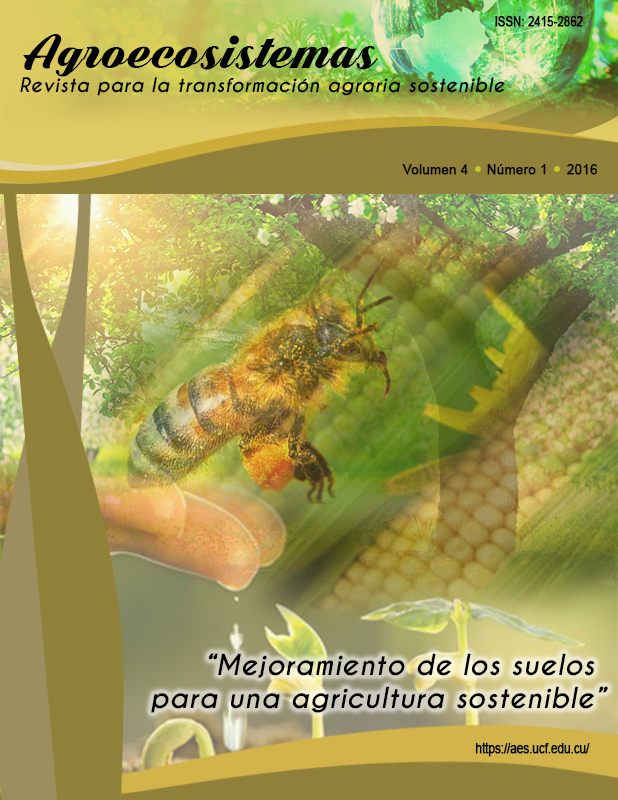Arvenses del género Solanum L. y cultivos asociados en agroecosistemas de tres municipios de Cienfuegos, Cuba
Abstract
Esta investigación tuvo como objetivo identificar las arvenses de género Solanum L. y cultivos asociados, así como la determinación de su carácter invasor, criterios de impacto y distribución potencial, en los municipios
Lajas, Cruces y Palmira. Fueron registradas durante los años 2011 y 2012 en tres municipios, las arvenses interceptadas del género Solanum, así como las detecciones por especie. Se agruparon los cultivos asociados
a estas arvenses por familia y bajo esta condición se evaluó el carácter invasor, criterios de impacto y distribución potencial. Fueron detectados S. Umbellatum Mill, S. globiferum Dunal, S. erianthum D. Don, S. nodiflorum
Jacq., S. sagraeanum A. Rich, S. torvum Sw, S. houstonii Dunal, S campechiense L, S. pimpinellifolium L, S. antillanum DE Schulz, S. mammosum L. Estas se asociaron a 17 cultivos de interés agrícola. Las plagas que pudieron afectar a las Solanáceas y cultivos asociados de mayor incidencia fueron Leptinotarsa undecemlineata, Meloidogyne spp, Phytophthora parasítica Dastur, Polyphagotarsonemus latus Banks, Fusarium sp y los Virus. Resultaron invasoras en el territorio: S. houstonii Dunal S. globiferum Dunal, y S. torvum Sw., pero las de mayor impacto coincidieron en cultivos asociados de la familia Poaceae y estas fueron S. globiferum, S houstonii y S. torvum. La especie de mayor distribución potencial en el territorio fue S. globiferum.
Palabras clave: malezas, Solanaceae, criterio de impacto, carácter invasor.
ABSTRACT
The objective of the investigation was to identify the weeds of the Solanum L. gender and the associated cultures, as well as the determination of its invasive character, impact criteria, and potential distribution, in Lajas, Cruces and Palmira municipalities. Weeds of the Solanum L. gender were registered during years 2011 and 2012 in tree municipalities, and were detected by species. The cultures associated to these weeds, were matched up by families, and under this condition, the invasive character, the impact criterion and the potential distribution were evaluated. Were detected: S. Umbellatum Mill, S. globiferum Dunal, S. erianthum D. Don, S. nodiflorum Jacq., S. sagraeanum A. Rich, S. torvum Sw, S. houstonii Dunal, S campechiense L, S. pimpinellifolium L, S. antillanum DE Schulz,
and S. mammosum L. These ones were associated to 17 cultures of agriculture interest. The plagues of higher incidence that could affect the Solanáceas and associated cultures were Leptinotarsa undecemlineata,
Meloidogyne spp, Phytophthora parasítica Dastur, Polyphagotarsonemus latus Banks, Fusarium sp and the virus. Were invasive in the territory: S. houstonii Dunal S. globiferum Dunal, y S. torvum Sw., but those of more impact coincide in the cultures associated of the family Poaceae and these were: S. globiferum, S houstonii and S. torvum. The specie of higher potential distribution in the territory was S. globiferum.
Keywords: weeds, solanaceae, impact criteria, invader character
Downloads
Published
How to Cite
Issue
Section
License
La editorial "Universo Sur", de la Universidad de Cienfuegos, publica el contenido de la Revista Científica Agroecosistemas bajo una Licencia Creative Commons Atribución-NoComercial-SinDerivar 4.0 Internacional.
© Podrá reproducirse, de forma parcial o total, el contenido de esta publicación, siempre que se haga de forma literal y se mencione la fuente.






